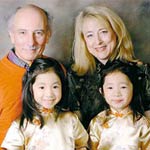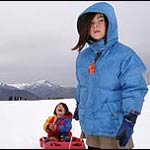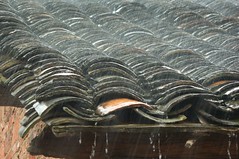Chinese Tax Chopsticks to Save Environment: China's Ministry of Finance announces a new plan to save millions of trees. It's imposing a tax on chopsticks. The Chinese -- and overseas lovers of Chinese food -- use 15 billion disposable wooden chopsticks each year. The chopstick tax is part of an effort by the Chinese government to protect its rapidly deteriorating environment.
Wednesday, April 05, 2006
Monday, April 03, 2006
News
China open to visit from Dalai Lama: China suggested Monday that it was open to a visit from the Dalai Lama and to establishing ties with the Vatican. The Dalai Lama, exiled spiritual leader of Tibetan Buddhists, announced last month that he hoped to travel to China on a pilgrimage.
Sunday, April 02, 2006
Friday, March 31, 2006
Local Story

Nicoloro family now adopting third daughter from China: After prominent careers in television on every network, in film and on stage, with a variety of titles and multiple Emmy nominations and awards, producers James Nicoloro and his wife, Kathleen Heller, are now enjoying parenthood. They are very happy to have the titles of "Momma" and "Poppa" to their 5-year-old twin daughters, Leigha and Juliette, adopted in China when they were 12 months old. The couple is now planning to adopt a third child, Wen Tao, 9, a special needs child also from China.
Jet Li and WuShu

King of the Kung-Fu Stars: From Shaolin Temple, to the series of Once Upon a Time in China, to the recent Danny the Dog and Fearless, Jet Li is a name closely connected with action movie, kung fu, and wushu (or martial arts).
[If you've never seen WuShu in action, check out this google video of the Beijing WuShu team.]
Thursday, March 30, 2006
Local Story

Child and prejudice: With Mother's Day approaching, Emily Buchanan recalls the suspicions and bureaucracy she had to overcome when she adopted two Chinese girls and brought them to Britain.
Hollywood News

Jessica Simpson ready to adopt baby: Jessica Simpson is thinking about joining the Hollywood adopt-a-baby-from-a-foreign-country club. "I want to adopt, and I plan to adopt before I have my own kids," the 25-year-old star tells TV's Extra.
News
Name for baby? Check out national database: Chinese parents may have to ponder less longer over their babies' names with a regulation on name registration being drafted. Instead of using whatever characters they want, parents might choose from a special database.
China's home-grown tech firms: Despite China's image as the sweatshop of the world, the country's homegrown technology sector is beginning to bloom.
China bans sale of organs in effort to control chaotic transplant industry: China said it would ban the trade in human organs, amid domestic pressure to regulate the chaotic industry and reports that Japanese and Malaysians had died from botched Chinese transplants.
Tuesday, March 28, 2006
Asian-American Statistics
The following was sent to me from a professor of Political Science at the University of Wisconsin Oshkosh. Because of length considerations, I did not include the info on Pacific Islanders, and I removed source information.
-------------------
2006 statistical portrait of the Asian American and Pacific Islander populations produced by the US Census Bureau for Asian Pacific American Heritage Month, which will take place in May, 2006. The portrait provides current census data, population projections, and internet links that should be useful for research, planning, writing and general educational purposes.
-------------------
Asians
14.0 million
The estimated number of U.S. residents in July 2004 who said they were Asian or Asian in combination with one or more other races. This group comprised 5 percent of the total population. California had both the largest population (4.8 million) and the largest numerical increase (123,000) of people of this group since July 2003; Hawaii is the state where Asians made up the highest proportion of the total population (58 percent).
3.4%
Percentage growth of the Asian population between 2003 and 2004, the highest of any race group during that time period.
Education
49%
The percentage of Asians, age 25 and older, who have a bachelor's degree or higher level of education. Asians have the highest proportion of college graduates of any race or ethnic group in the country.
87%
The percentage of Asians, age 25 and older, who are high school graduates.
20%
The percentage of Asians, age 25 and older, who have an advanced degree (e.g., master's, Ph.D., M.D. or J.D.).
The Asian population is comprised of many groups who differ in languages spoken, culture and length of residence in the United States. This is reflected in the demographic characteristics of these groups. For instance, 68 percent of Asian Indians, age 25 and older, had a bachelor's degree or more education and 37 percent had a graduate or professional degree; the corresponding numbers for Vietnamese-Americans were 24 percent and 7 percent, respectively
Income and Poverty
$57,518
Median household income for Asians in 2004, the highest among all race groups.
Median household income differed greatly by Asian group. For Asian Indians, for example, the median income in 2004 was $68,771; for Vietnamese-Americans, it was $45,980.
9.8%
Poverty rate for Asians in 2004, down from 11.8 percent in 2003.
Businesses
1.1 million
Number of businesses owned by Asian-Americans in 2002, up 24 percent from 1997.
$343.3 billion
Receipts of Asian-American-owned businesses in 2002, up 13 percent from 1997. An estimated 319,911 Asian-owned businesses had paid employees; and their receipts totaled $307.6 billion, or about $961,379 per firm.
* About 28 percent of Asian-American-owned firms were in health care and other services, with another 14 percent each in professional services and retail trade.
* Asian-American-owned firms accounted for 45 percent of businesses in Hawaii, 13 percent of firms in California and 9 percent in New York.
Languages
2.3 million
The number of people age 5 and older who speak Chinese at home. After Spanish, Chinese is the most widely spoken non-English language in the country. Tagalog and Vietnamese also have more than 1 million speakers.
Coming to America
8.7 million
The number of U.S. residents who were born in Asia. Asian-born residents comprise one-fourth of the nation's total foreign-born population.
52%
The percentage of the foreign-born from Asia who are naturalized U.S. citizens.
1.8 million
The estimated number of foreign-born people from China. Following Mexico, China is the leading country of birth for the nation's foreign-born. Other nations contributing at least 1 million foreign-born to our nation include India and the Philippines. The estimate for China includes Taiwan and Hong Kong.
Serving Our Nation
282,000
The number of Asian-American military veterans.
Families
60%
The proportion of Asian households consisting of a married-couple family.
Jobs
46%
The proportion of employed Asians 16 and older who work in management, professional and related occupations, such as financial managers, engineers, teachers and registered nurses.
Counties
1.4 million
The number of Asians in Los Angeles County, Calif., which tops the nation's counties. From 2003 to 2004, this county also experienced the largest numerical increase of Asians (25,200).
Age Distribution
26%
Percent of people on July 1, 2004, identifying themselves as either Asian or Asian in combination with one or more other races who are under 18; 8 percent are 65 or older.
Note: American Community Survey estimates are based on the population of one race only and do not include those living in group quarters.

